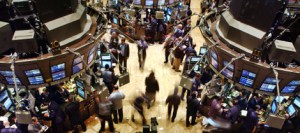SCCO

September 24, 2024 | Daily JAM, Dividend Income, Morning Briefing, SCCO, Short Term, Top 50 Stocks |
There was a whiff of panic to the big moves by the People’s Bank today.China’s central bank cut a key short-term interest rate and announced plans to reduce the reserve ratio, the amount of money banks must hold in reserve, to the lowest level since at least 2018. This marked the first time reductions to both measures were revealed on the same day since at least 2015. And that wasn’t all.

September 12, 2024 | Daily JAM, Long Term, Morning Briefing, SCCO, Stock Alerts, Top 50 Stocks |
China’s copper imports in August dropped by 12.3% from the previous year, preliminary official Chinese customs data showed on Tuesday, September 10. It’s yet another sign that the slowdown in Chinese economy is rippling out into the global economy.

October 24, 2023 | AAPL, ALB, CAT, Daily JAM, DE, Dividend Income, DUK, F, GM, Jubak Picks, Mid Term, NI, SCCO, Short Term, Special Reports, Top 50 Stocks |
I’ve hi-lighted the key characteristics of the coming global debt bomb explosion that investors MUST include in any plan to protect a portfolio from the explosion of this bomb.

September 26, 2023 | AAPL, ADBE, ALB, AMAT, EUM, GOLD, LAC, Morning Briefing, MSFT, NVDA, PILBF, RWM, SCCO, Short Term, Special Reports, UUP, Volatility |
So what do you do with your portfolio for the rest of 2023? And what’s your best strategy to be prepared for 2024? In Part 1 of this Special Report I laid out the 10 developments that I thought would drive the financial markets for the rest of 223 and into 2024. Today, in Part 2, I’m going to give you the first 2 of 10 moves to take–with as much detail and as many specifics as possible–that you should be making now to position your portfolio for the uncertainties of the last quarter of 2023.

September 14, 2023 | Daily JAM, Dividend Income, Jubak Picks, Mid Term, SCCO, Top 50 Stocks |
The People’s Bank of China cut the amount of cash banks must hold in reserve for the second time this year. The move is an effort to boost flagging economic growth in China. The bank could have cut its benchmark interest rate in pursuit of the same goal. But that would have led to more selling against the yuan and the People’s Bank has been busy in the trenches in recent weeks trying to prop up the yuan agains the dollar. The question, of course, is whether the cut in reserve requirements will be enough, without a reduction in interest rates, to revive growth in China’s economy.

June 14, 2023 | ADBE, ALB, AMAT, CMI, Daily JAM, Dividend Income, GOOG, JCI, Jubak Picks, Long Term, MSFT, NVDA, SCCO, Top 50 Stocks |
I think a well-constructed portfolio should resemble an onion. (Yes, to continue the analogy, it may make you cry in the short term, but the end result after cooking time is yummy.) At the center of that onion is a core built of stocks with extremely high, risk-adjusted potential rates of return. These stocks won’t deliver the kind of huge gains you can reap from investing in a risky bet–if everything turns out right for that company and its stock. But neither are they likely to crash and burn because something goes wrong at the company. These core portfolio stocks will drop if the market as a whole heads south, but they will drop less and recover faster. These aren’t buy-and-forget, or hold-forever stocks. They can soar to unreasonable valuations at times and an active investor should take profits at some point of overvaluation. (I did a YouTube video recently (you can find it on any of my sites) on when to sell a very overvalued Nvidia, for example.) And they can trade at big discounts to fair value (which is, of course, when the steely-eyed among us will buy) because management has made a mistake or between the industry in which they do business is slumping, or because the market for the company’s goods and services has taken an unexpected direction. At that point, you’ll need to consider selling or adding to your positions depending on your analysis of how long the damage might last and how bad it is. But the point of this core to your stock portfolio is that these are companies that will deliver index-beating results with relatively small risks. Which will enable you, the investor, to plan how to achieve your financial goals with relatively less worry and uncertainty. So, without further ado, here’s my list of 10 stocks for a core portfolio–with the very important “whys” for each pick.

March 8, 2023 | Daily JAM, FQVLF, Millennial, SCCO |
First Quantum Minerals (FQVLF) has reached an agreement on a new concession contract with Panama’s government over its huge Cobre Panama copper mine. The agreeent, assuming tht a final signing goes ahead, would end a months-long dispute that has halted ore processing and export shipments. The Cobre Panama mine accounted, before the dispute, for 1.5% of global copper production.

October 5, 2022 | Daily JAM, FCX, FQVLF, SCCO |
Copper gained after the London Metal Exchange said it will restrict new deliveries of the metals from Russia’s Ural Mining & Metallurgical Co. and one of its subsidiaries.

May 17, 2022 | ALB, Daily JAM, DAL, DE, DIS, FQVLF, Long Term, MRVL, NVDA, PFE, SCCO, USB, Volatility |
In my weekend Saturday Night Quarterback I said that this week would, probably, answer the question of whether Friday’s big bounce was just a bounce, the start of a buy on the dip rally, or even a bear market rally with a bit of staying power. Two days into the week I think the market action is moving in favor of a bear market rally, one of those often quite powerful upside moves that punctuate extended bear markets.

May 2, 2022 | CMI, Daily JAM, DNNGY, ES, FQVLF, JCI, LICY, Long Term, SCCO, Special Reports, Top 50 Stocks |
All you have to do to find the high profits that will make the risk of investing in climate change stocks worthwhile is to focus on sectors (1) where the rewards are solid and the risk is quantifiable, (2) where companies are making profit the old-fashioned way by building out networks and then charging high rents to use them, by (3) carefully targeting a few technologies (wind and solar and hydrogen and electric cars) that will be part of any mix of solutions, and (4) by investing in bottlenecks that are likely to drive prices up (and provide good profits for companies that resolve the bottleneck.

November 2, 2021 | Daily JAM, FCX, FQVLF, Jubak Picks, NJDCY, SCCO, Top 50 Stocks, Volatility, VWAPY |
When I started Special Report for how to Buy on the Dip, What to Buy on the Dip and When to Buy on the Dip I was only looking to have three strategies (and 10 picks). The more I look at the current market, the more complex it seems with more moving parts that could generate an Oh, No! moment for this stock or that stock. Which is why I’ve added a fourth strategy, one I’m calling “The China bomb” and four more picks to my Buy on the Dip Special Report.

August 17, 2021 | COPX, CPER, Daily JAM, Dividend Income, Millennial, SCCO, Top 50 Stocks |
On Monday the Chinese government reported that the country’s economy slowed more than expected in July. Retail sales were crimped by tough new virus restrictions introduced toward the end of the month to contain fresh outbreaks. Retail sales rose by 8.5% near over year. Analysts had expected growth of 10.9%. Industrial production to a 6.4% year over year increase instead of the 7.9% in economist forecasts. Investment in fixed assets rose 10.3% year to year in the first seven months of 2021 against expectations for an 11.3% increase. No big secret about the effects. China’s economy is the driver for global demand for commodities such as copper. And for demand for some key manufactured goods such as chips.












